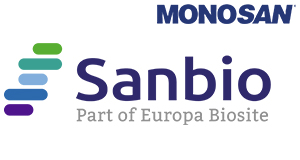Mouse anti-VCAM-1, clone 1G11B1 (Monoclonal)
Mouse anti-VCAM-1, clone 1G11B1 (Monoclonal)
Artikelnummer
SANMON6017
Verpackungseinheit
1 ml
Hersteller
Sanbio / Monosan
Verfügbarkeit:
wird geladen...
Preis wird geladen...
Clone Number: 1G11B1
Immunogen: Unknown or proprietery to MONOSAN and/or its suppliers
Concentration: 100 ug/ ml
Storage buffer: PBS with 0.1% BSA and 0.02% sodium azide
Additional info: The monoclonal antibody 1G11B1 recognizes vascular cell adhesion molecule-1 (VCAM-1). VCAM-1 is a member of the immunoglobulin superfamily of adhesion molecules, which includes ICAMs, PECAM-s and MADCAM, and is involved in leukocyte-endothelial cell interactions. The immunoglobulin superfamily is a type I transmembrane protein characterized by extracellular immunoglobin domains, a transmembrane region and a cytoplasmic tail. They are essential for the development of the embryo and for immune and inflammatory responses. These transmembrane glycoproteins mediate cell interaction with, and adhesion to, other cells and the extracellular matrix. VCAM-1 contains six immunoglobulin domains of the H-type and interacts with VLA-4 expressed on leukocytes. Multiple adhesion molecules play a role in leukocyte recruitment. The process of migration of a leukocyte through the vascular endothelium consists of the following steps: leukocyte-endothelium interaction (first tethering and rolling and than adhesion) and transendothelial migration. VCAM-1 is almost not expressed under physiological conditions. However, under appropriate pro-inflammatory conditions where the endothelium is exposed to inflammatory cytokines such as tumour necrosis factor-α or IL-1b and becomes activated, VCAM-1 gene expression is rapid elevated by the vascular endothelium. There is also a soluble form of VCAM-1 which is angiogenic and chemotactic for endothelial cells. sVCAM-1 is up-regulated in several disease states (eg, myocardial infarction, type 2 diabetes mellitus, primary antiphospholipid syndrome, and rheumatoid arthritis).
References: Thornhill; M et al. J Immunology 1991; 146: 592/Van der Vieren, M et al. J Immunol 1999, 163:1984/Dienst; A et al. J Natl Cancer Inst 2005; 97 :733
Immunogen: Unknown or proprietery to MONOSAN and/or its suppliers
Concentration: 100 ug/ ml
Storage buffer: PBS with 0.1% BSA and 0.02% sodium azide
Additional info: The monoclonal antibody 1G11B1 recognizes vascular cell adhesion molecule-1 (VCAM-1). VCAM-1 is a member of the immunoglobulin superfamily of adhesion molecules, which includes ICAMs, PECAM-s and MADCAM, and is involved in leukocyte-endothelial cell interactions. The immunoglobulin superfamily is a type I transmembrane protein characterized by extracellular immunoglobin domains, a transmembrane region and a cytoplasmic tail. They are essential for the development of the embryo and for immune and inflammatory responses. These transmembrane glycoproteins mediate cell interaction with, and adhesion to, other cells and the extracellular matrix. VCAM-1 contains six immunoglobulin domains of the H-type and interacts with VLA-4 expressed on leukocytes. Multiple adhesion molecules play a role in leukocyte recruitment. The process of migration of a leukocyte through the vascular endothelium consists of the following steps: leukocyte-endothelium interaction (first tethering and rolling and than adhesion) and transendothelial migration. VCAM-1 is almost not expressed under physiological conditions. However, under appropriate pro-inflammatory conditions where the endothelium is exposed to inflammatory cytokines such as tumour necrosis factor-α or IL-1b and becomes activated, VCAM-1 gene expression is rapid elevated by the vascular endothelium. There is also a soluble form of VCAM-1 which is angiogenic and chemotactic for endothelial cells. sVCAM-1 is up-regulated in several disease states (eg, myocardial infarction, type 2 diabetes mellitus, primary antiphospholipid syndrome, and rheumatoid arthritis).
References: Thornhill; M et al. J Immunology 1991; 146: 592/Van der Vieren, M et al. J Immunol 1999, 163:1984/Dienst; A et al. J Natl Cancer Inst 2005; 97 :733
| Artikelnummer | SANMON6017 |
|---|---|
| Hersteller | Sanbio / Monosan |
| Hersteller Artikelnummer | MON6017 |
| Verpackungseinheit | 1 ml |
| Mengeneinheit | STK |
| Reaktivität | Human |
| Klonalität | Monoclonal |
| Methode | Immunofluorescence, Immunohistochemistry (frozen), Immunoprecipitation, Flow Cytometry, Functional Assay |
| Isotyp | IgG1 |
| Wirt | Mouse |
| Konjugat | Unconjugated |
| Produktinformation (PDF) | Download |
| MSDS (PDF) |
|

 English
English







